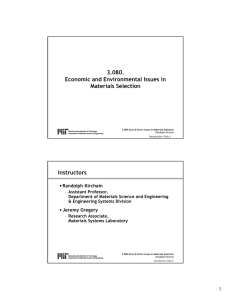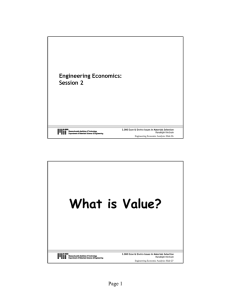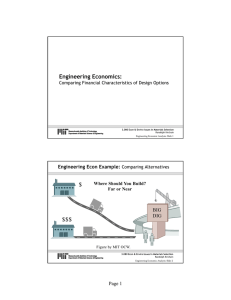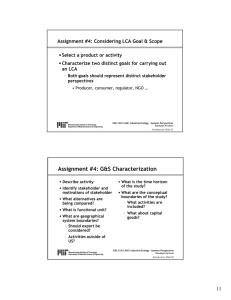Engineering Economics: Session 3 Randolph Kirchain
advertisement
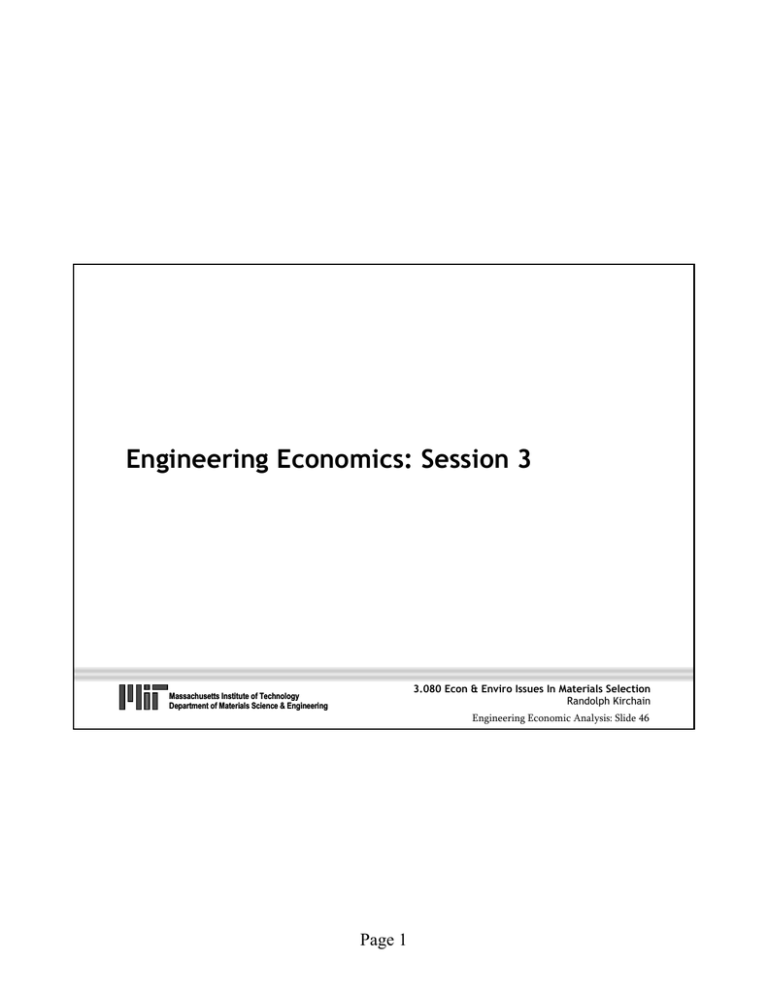
Engineering Economics: Session 3 3.080 Econ & Enviro Issues In Materials Selection Randolph Kirchain Massachusetts Institute of Technology Department of Materials Science & Engineering Engineering Economic Analysis: Slide 46 Page 1 Example Problem: Geometric Series • Facility has aging cooling system which currently runs 70% of the time the plant is open – Pump will only last 5 more years. As it deteriorates, the pump run time is expected to increase 7% per year • New cooling system would only run 50% of the time • Assumptions – Either pump uses 250 kWh, Electricity cost $0.05/KWh – Plant runs 250 days per year, 24 hours per day – Firm’s discount rate is 12% • What is the value of replacing the pump? 3.080 Econ & Enviro Issues In Materials Selection Randolph Kirchain Massachusetts Institute of Technology Department of Materials Science & Engineering Engineering Engineering Economic Analysis: Slide 47 Page 2 Example Problem: Geometric Series • Current pump power cost = POld 70% x 250kWh x $0.05/kWh x 250 days x 24 PNew hrs/day = $52,500 • New pump power Cost = $37,500 ⎛ 1 − (1.07)5 (1.12) −5 ⎞ = $52, 500 ⎜ ⎟ 0.12 − 0.07 ⎝ ⎠ = $214, 400 = $37, 500( P / A,12%, 5) PNew = $37, 500(3.605) = $135, 200 Value = POld − PNew = $79,160 Massachusetts Institute of Technology Department of Materials Science & Engineering 3.080 Econ & Enviro Issues In Materials Selection Randolph Kirchain Engineering Economic Analysis: Slide 48 Page 3 Example Problem: Geometric Series $100 $80 $60 $40 $20 $0 0 1 2 3 4 5 Energy Cost - A1 A1(1+g) A1(1+g)2 A1(1+g)3 A1(1+g)4 Energy Cost $0.00 $52.50 $56.18 $60.11 $64.31 $68.82 Present Value $0.00 $46.88 $44.78 $42.78 $40.87 $39.05 Future Value $0.00 $82.61 $78.92 $75.40 $72.03 $68.82 Massachusetts Institute of Technology Department of Materials Science & Engineering 3.080 Econ & Enviro Issues In Materials Selection Randolph Kirchain Engineering Economic Analysis: Slide 49 Page 4 Hundreds Combining Concepts $14 Present Value Cash Flow Future Value $12 $10 $8 $6 $4 $2 $0 ($2) 0 1 2 Massachusetts Institute of Technology Department of Materials Science & Engineering 3 4 5 6 7 8 3.080 Econ & Enviro Issues In Materials Selection Randolph Kirchain Engineering Economic Analysis: Slide 50 Page 5 Effective Interest Rate • So far -- assumed compounding at end of period (& mostly 1year periods) • What if Image removed for copyright reasons. Screenshot of bank website page describing its savings products, highlighting the statement "Daily compounding interest with tiered interest rate structure." compounding happens more frequently? 3.080 Econ & Enviro Issues In Materials Selection Randolph Kirchain Massachusetts Institute of Technology Department of Materials Science & Engineering Engineering Economic Analysis: Slide 51 Page 6 Image removed for copyright reasons. Screenshot of Bankrate.com mortgage comparison table; highlighting the difference between published Rate and APR. 3.080 Econ & Enviro Issues In Materials Selection Randolph Kirchain Massachusetts Institute of Technology Department of Materials Science & Engineering Engineering Economic Analysis: Slide 52 Page 7 Effective Interest Rate • By convention, most interest rates are quoted on an annual basis – e.g., 2% interest, with an interest period of 1 month Æ stated as 24% compounded monthly • How does this differ from 24% compounded annually? – F@1month = P(1.02) – F@2 months = P(1.02)(1.02) – F@12months = P(1.02)12 = 1.2682P – Effective interest rate = 26.82% • Effective interest rate (ie) r = nominal annual interest rate M = compounding periods per year i e = (1+ r M ) −1 M 3.080 Econ & Enviro Issues In Materials Selection Randolph Kirchain Massachusetts Institute of Technology Department of Materials Science & Engineering Engineering Engineering Economic Analysis: Slide 53 Page 8 The impact of compounding Rate of Return (%/year) 12.7% Nominal Rate Effective Rate Days per Period 12.6% 12.5% 12.4% 300 200 12.3% 12.2% 100 12.1% 12.0% 11.9% 0 20 40 60 80 Days per Year 400 12.8% 0 100 Number of Compounding Period per Year Massachusetts Institute of Technology Department of Materials Science & Engineering 3.080 Econ & Enviro Issues In Materials Selection Randolph Kirchain Engineering Economic Analysis: Slide 54 Page 9 Effective Interest Rates When you want to express ie annually: i e = (1+ r M ) −1 M Or more generally, for an arbitrary period: r C ) −1 i e = (1 + CK C = The number of interest periods per payment period K = The number of payment periods per year Note that r is still assumed to be expressed annually Massachusetts Institute of Technology Department of Materials Science & Engineering 3.080 Econ & Enviro Issues In Materials Selection Randolph Kirchain Engineering Economic Analysis: Slide 55 Page 10 Suppose you deposit into your retirement account $1,000 at the end of each year The retirement account compounds quarterly, Nominal rate = 12% What is the value after 10 years? 3.080 Econ & Enviro Issues In Materials Selection Randolph Kirchain Massachusetts Institute of Technology Department of Materials Science & Engineering Engineering Economic Analysis: Slide 56 Page 11 Off Period Compounding • Payments more frequent than compounding – Either • Use effective rate for payment period, or • Aggregate payments within a given period – Use this only if, interest doesn’t accrue during period • Payments less frequent than compounding period – Compute • Effective interest rate for period • Effective payment for interest rate Massachusetts Institute of Technology Department of Materials Science & Engineering 3.080 Econ & Enviro Issues In Materials Selection Randolph Kirchain Engineering Economic Analysis: Slide 57 Page 12 Example of off period compounding: Cash Flows Less Frequent then Compounding • Suppose you deposit into your retirement account $1,000 at the end of each year • The retirement account compounds quarterly – Nominal rate = 12% • What is the value after 10 years? Massachusetts Institute of Technology Department of Materials Science & Engineering 3.080 Econ & Enviro Issues In Materials Selection Randolph Kirchain Engineering Economic Analysis: Slide 58 Page 13 Example of off period compounding: Cash Flows Less Frequent then Compounding (cont) • Equivalent rate • Value of payments after 10 years Massachusetts Institute of Technology Department of Materials Science & Engineering 3.080 Econ & Enviro Issues In Materials Selection Randolph Kirchain Engineering Economic Analysis: Slide 59 Page 14 Example of off period compounding: Cash Flows Less Frequent then Compounding (cont) • Equivalent payment $1,200 Actual $1,000 Effective $800 $600 $400 $200 $0 0 3 6 9 12 15 18 21 24 27 30 33 36 Months Massachusetts Institute of Technology Department of Materials Science & Engineering 3.080 Econ & Enviro Issues In Materials Selection Randolph Kirchain Engineering Economic Analysis: Slide 60 Page 15 Very Small Compounding Periods i e = (1 + r M ) −1 M F = P (1 + i )N = P (1 + e r − 1)N M let x = r = Pe rN r x ⎛⎛ 1⎞ ⎞ ie = ⎜ ⎜ 1 + ⎟ ⎟ − 1 ⎜ x ⎠ ⎠⎟ ⎝⎝ As M → ∞, x → ∞ x r ⎡⎛ ⎤ ⎞ 1 ⎛ ⎞ lim i e = lim ⎢⎜ ⎜ 1 + ⎟ ⎟ − 1⎥ = e r − 1 x →∞ x →∞ ⎢⎜ ⎥ x ⎠ ⎠⎟ ⎝ ⎝ ⎣ ⎦ Massachusetts Institute of Technology Department of Materials Science & Engineering F=Pern 3.080 Econ & Enviro Issues In Materials Selection Randolph Kirchain Engineering Economic Analysis: Slide 61 Page 16 Using Spreadsheets: Two Key Strategies • Parametrize – Try to always put values in their own cells – Try not to embed values in formulae • Rely on Data Tables for sensitivity analysis Massachusetts Institute of Technology Department of Materials Science & Engineering 3.080 Econ & Enviro Issues In Materials Selection Randolph Kirchain Engineering Economic Analysis: Slide 62 Page 17 Using Spreadsheets: Excel Formulae for Equivalence Geometric Gradient Linear Gradient Uniform Series Single Type Notation Formula Compound Amount (F/P,i,N) Present Worth (P/F,i,N) Compound Amount (F/A, i, N) F = P(1 + i) P = F /(1 + i ) N PV(i,N,,P) ⎛ (1 + i ) N − 1 ⎞ F = A⎜ ⎟ i ⎝ ⎠ FV(i,N,A) Sinking Fund (A/F, i, N) ⎛ ⎞ i A= F⎜ ⎟ N i (1 + ) − 1 ⎝ ⎠ PMT(i,N,0,F) Present Worth (P/A, i, N) ⎛ (1 + i ) N − 1 ⎞ P = A⎜ N ⎟ ⎝ i (1 + i) ⎠ PV(i,N,A) Capital Recovery (A/P, i, N) ⎛ i (1 + i) N ⎞ A = P⎜ ⎟ N ⎝ (1 + i ) − 1 ⎠ PMT(i,N,P) Present Worth (P/G, i, N) ⎛ (1 + i ) N − iN − 1 ⎞ P = G⎜ ⎟ 2 N ⎝ i (1 + i ) ⎠ manual Present Worth (P/A1,g, i, N) Massachusetts Institute of Technology Department of Materials Science & Engineering Excel FV(i,N,,P) N ⎧ ⎛ 1 − (1 + g ) N (1 + i) − N ⎞ ⎪ A1 ⎜ ⎟ i−g ⎪ ⎠ P=⎨ ⎝ manual NA1 ⎪ = i g ,if 3.080 Econ & Enviro Issues In Materials Selection ⎪⎩ (1 + i ) Randolph Kirchain Engineering Economic Analysis: Slide 63 Page 18 Evaluating Alternatives Is This Worth Doing? 3.080 Econ & Enviro Issues In Materials Selection Randolph Kirchain Massachusetts Institute of Technology Department of Materials Science & Engineering Engineering Economic Analysis: Slide 64 Page 19 Evaluating “Projects” or Alternatives • Does a project provide benefits (revenues) that exceed – Equivalent expenditures – Return on capital Over a 5 year period, your firm can make $22,000 by running copy service. The associated costs are: $4,000 to buy copier (salvage value of $1,000) $2,200 to maintain and operate copier Does it make sense to invest in this business? Massachusetts Institute of Technology Department of Materials Science & Engineering 3.080 Econ & Enviro Issues In Materials Selection Randolph Kirchain Engineering Economic Analysis: Slide 65 Page 20 Evaluating “Projects” or Alternatives • Does a project provide benefits (revenues) that exceed – Equivalent expenditures – Return on capital • Minimum Attractive Rate of Return (MARR) – Cost of using funds (e.g., if borrowed) – Return from other available options – Risk of project under consideration Massachusetts Institute of Technology Department of Materials Science & Engineering 3.080 Econ & Enviro Issues In Materials Selection Randolph Kirchain Engineering Economic Analysis: Slide 66 Page 21 Determining MARR Logical Method: Capital Rationing • Insufficient capital to 50% – Actually, capital available, but at escalating cost • MARR comes from – return of best rejected project Annual Rate of Return fund all projects – with return greater than cost of acquiring capital Massachusetts Institute of Technology Department of Materials Science & Engineering 40% 30% 20% 10% 0% 0 10 20 30 40 Cumulative Investment (millions $) 3.080 Econ & Enviro Issues In Materials Selection Randolph Kirchain Engineering Economic Analysis: Slide 67 Page 22 50 Determining Equivalence: Present Worth Method – Net Present Value • Present Worth (PW) Method – comparing equivalent worth of all cash flows at present time • Positive PW = Project has return greater than MARR – PW measures how much money one could afford to pay for the investment in excess of its cost – Positive PW for an project is amount of profit over the minimum amount required Massachusetts Institute of Technology Department of Materials Science & Engineering 3.080 Econ & Enviro Issues In Materials Selection Randolph Kirchain Engineering Economic Analysis: Slide 68 Page 23 Computing Present Worth • To compute present worth – Calculate discounted cash flow (i.e., present worth of each cash flow) – Sum all discounted cash flows • Project is worth considering if PW > 0 Over a 5 year period, your firm can make $22,000 by running copy service. MARR=12% The associated costs are: $4,000 to buy copier (salvage value of $1,000) $2,200 to maintain and operate copier Massachusetts Institute of Technology Department of Materials Science & Engineering 3.080 Econ & Enviro Issues In Materials Selection Randolph Kirchain Engineering Economic Analysis: Slide 69 Page 24 Present Worth Example: Invest in the Copier? • How does this set of expected cash flows compare to simply investing $4,000 at 12%? $4,300 $5,000 $4,000 $3,300 $3,300 $3,300 $3,300 1 2 3 4 5 $2,200 $2,200 $2,200 $2,200 $2,200 $3,000 $2,000 $1,000 $0 ($1,000) 0 ($2,000) ($3,000) ($4,000) ($5,000) $4,000 Massachusetts Institute of Technology Department of Materials Science & Engineering 3.080 Econ & Enviro Issues In Materials Selection Randolph Kirchain Engineering Economic Analysis: Slide 70 Page 25 Determining Equivalence Annual Worth Method • Annual Worth (AW) of a project is the series of equals payments with value equivalent to that project at the MARR – AW = Annual Equivalent Revenues – Annual Equivalent Expenses – Annual Equivalent Capital Recovery – Capital Recovery = Equivalent uniform annual cost of capital invested • Loss in value of the asset • Return on invested capital Massachusetts Institute of Technology Department of Materials Science & Engineering 3.080 Econ & Enviro Issues In Materials Selection Randolph Kirchain Engineering Economic Analysis: Slide 71 Page 26 Annual Equivalent – Calculating Capital Recovery • AW = R – E – Capital Recovery • Capital recovery = Annual Equivalent of Investment - Annual Equivalent of Salvage Value Massachusetts Institute of Technology Department of Materials Science & Engineering 3.080 Econ & Enviro Issues In Materials Selection Randolph Kirchain Engineering Economic Analysis: Slide 72 Page 27 Annual Worth Example • Producing cars is highly capital intensive with a new car factory costing nearly $1 billion dollars • A new technology has been developed that speeds the assembly of vehicles. It has the following characteristics: – Current plant – 30 stations, output = 200k per year – Profit = $1000 per vehicle – Investment - $300k per station, 30 stations per plant – Salvage value $60k per station – Maintenance cost - $20k / station / year – Improved throughput – 1% – Investments replaced after 5 years – MARR = 15% Massachusetts Institute of Technology Department of Materials Science & Engineering Should you install this tech? 3.080 Econ & Enviro Issues In Materials Selection Randolph Kirchain Engineering Economic Analysis: Slide 73 Page 28 Annual Worth Example (cont) $3.8 $4 $2 $2.0 $2.0 $2.0 $2.0 1 2 3 4 5 $0.6 $0.6 $0.6 $0.6 $0.6 $0 ($2) 0 ($4) ($6) ($8) ($10) $9.0 Massachusetts Institute of Technology Department of Materials Science & Engineering 3.080 Econ & Enviro Issues In Materials Selection Randolph Kirchain Engineering Economic Analysis: Slide 74 Page 29 Determining Equivalence: Internal Rate of Return (IRR) • IRR method solves for the rate of return for which Equivalent worth for cash inflows = Equivalent worth of cash outflows – i.e., Present Worth = Annualized Worth = 0 • This rate is called the IRR • If IRR < MARR, then project is NOT acceptable • If IRR ≥ MARR, then project IS acceptable Massachusetts Institute of Technology Department of Materials Science & Engineering 3.080 Econ & Enviro Issues In Materials Selection Randolph Kirchain Engineering Economic Analysis: Slide 75 Page 30 IRR Example $6,000 $3,800 $4,000 $2,000 $0 ($2,000) 0 1 2 3 4 5 ($4,000) ($6,000) $5,000 • What interest rate will make worth of inflows = outflows? Massachusetts Institute of Technology Department of Materials Science & Engineering 3.080 Econ & Enviro Issues In Materials Selection Randolph Kirchain Engineering Economic Analysis: Slide 76 Page 31 Issues with the IRR method • IRR assumes that cash flows can be reinvested at the IRR over course of study – For projects with IRR >> MARR this may be unrealistic • Can have multiple IRR for cash flows, if net cash flows reverse signs more than once over study period Massachusetts Institute of Technology Department of Materials Science & Engineering 3.080 Econ & Enviro Issues In Materials Selection Randolph Kirchain Engineering Economic Analysis: Slide 77 Page 32 Payback Period • Simple payback – Number of periods (θ) for cash inflows to equal / exceed cash outflows θ ∑ (R k − Ek ) ≥ I k where: Rk is revenues in period k Ek = expenses in period k I = initial investment • Payback period does not indicate profitability – Represents liquidity – Used to estimate risk Æ lower = less risk Massachusetts Institute of Technology Department of Materials Science & Engineering 3.080 Econ & Enviro Issues In Materials Selection Randolph Kirchain Engineering Economic Analysis: Slide 78 Page 33
